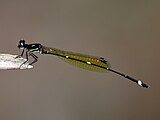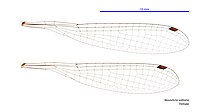Nososticta solitaria
| Fivespot threadtail | |
|---|---|

| |
| Fivespot threadtail, Queensland | |
| Scientific classification | |
| Domain: | Eukaryota |
| Kingdom: | Animalia |
| Phylum: | Arthropoda |
| Class: | Insecta |
| Order: | Odonata |
| Suborder: | Zygoptera |
| Family: | Platycnemididae |
| Genus: | Nososticta |
| Species: | N. solitaria
|
| Binomial name | |
| Nososticta solitaria | |

| |
Nososticta solitaria is an Australian species of damselfly in the family Platycnemididae,[3] commonly known as the fivespot threadtail. It is found only in north-eastern Australia.[4]
Its usual habitat is near rivers, streams and pools. The adult is a medium-sized damselfly with a length of 35 to 40mm, and wingspan similar to its length. The thorax is black with two pale green stripes. The abdomen is dark with five prominent pale or green bands, the largest being on segments 5 and 8. The wings of the male have a yellowish tint, which may also be seen on the female. In Australia, the distribution is in suitable habitat in the north-eastern part of the continent from the tip of Cape York Peninsula to the southern Queensland border.[4] The taxon has not been assessed in the IUCN Red List.
Gallery
-
Male in Cairns
-
Female in Cairns
-
Female wings
-
Male wings
See also
References
- ^ Hawking, J. (2009). "Nososticta solitaris". IUCN Red List of Threatened Species. 2009: e.T163565A5616757. doi:10.2305/IUCN.UK.2009-2.RLTS.T163565A5616757.en.
- ^ Tillyard, R.J. (1906). "New Australian species of the family Agrionidae (Neuroptera: Odonata)". Proceedings of the Linnean Society of New South Wales. 31: 177–194 [182] – via Biodiversity Heritage Library.
- ^ "Species Nososticta solitaria (Tillyard, 1906)". Australian Faunal Directory. Australian Biological Resources Study. 2012. Retrieved 14 April 2017.
- ^ a b Theischinger, G; Hawking, J (2006). The Complete Field Guide to Dragonflies of Australia. Collingwood, Victoria: CSIRO Publishing. p. 62. ISBN 978 0 64309 073 6.





